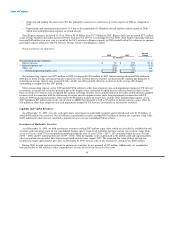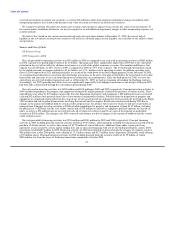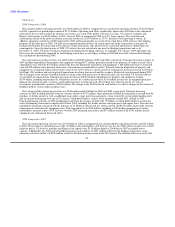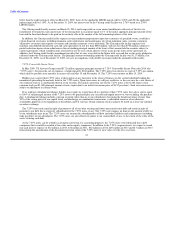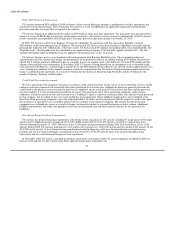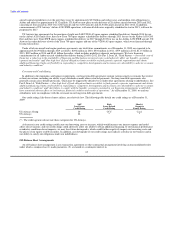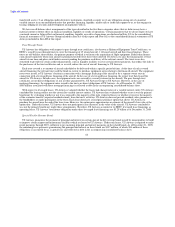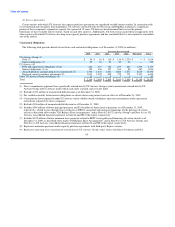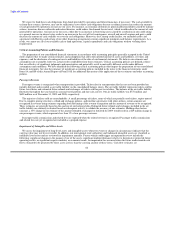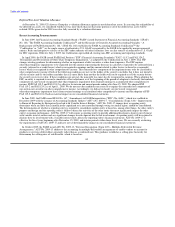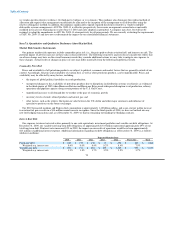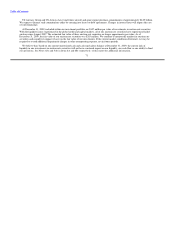US Airways 2009 Annual Report Download - page 68
Download and view the complete annual report
Please find page 68 of the 2009 US Airways annual report below. You can navigate through the pages in the report by either clicking on the pages listed below, or by using the keyword search tool below to find specific information within the annual report.
Table of Contents
We expect to fund these cash obligations from funds provided by operations and future financings, if necessary. The cash available to
us from these sources, however, may not be sufficient to cover these cash obligations because economic factors may reduce the amount
of cash generated by operations or increase our costs. For instance, an economic downturn or general global instability caused by military
actions, terrorism, disease outbreaks and natural disasters could reduce the demand for air travel, which would reduce the amount of cash
generated by operations. An increase in our costs, either due to an increase in borrowing costs caused by a reduction in our credit rating
or a general increase in interest rates or due to an increase in the cost of fuel, maintenance, aircraft and aircraft engines and parts, could
decrease the amount of cash available to cover the cash obligations. Moreover, the Citicorp credit facility, our amended credit card
agreement with Barclays and certain of our other financing arrangements contain significant minimum cash balance requirements. As a
result, we cannot use all of our available cash to fund operations, capital expenditures and cash obligations without violating these
requirements.
Critical Accounting Policies and Estimates
The preparation of our consolidated financial statements in accordance with accounting principles generally accepted in the United
States requires that we make certain estimates and assumptions that affect the reported amount of assets and liabilities, revenues and
expenses, and the disclosure of contingent assets and liabilities at the date of our financial statements. We believe our estimates and
assumptions are reasonable; however, actual results could differ from those estimates. Critical accounting policies are defined as those
that are reflective of significant judgments and uncertainties and potentially result in materially different results under different
assumptions and conditions. We have identified the following critical accounting policies that impact the preparation of our consolidated
financial statements. See also the summary of significant accounting policies included in the notes to the financial statements under
Items 8A and 8B of this Annual Report on Form 10-K for additional discussion of the application of these estimates and other accounting
policies.
Passenger Revenue
Passenger revenue is recognized when transportation is provided. Ticket sales for transportation that has not yet been provided are
initially deferred and recorded as air traffic liability on the consolidated balance sheets. The air traffic liability represents tickets sold for
future travel dates and estimated future refunds and exchanges of tickets sold for past travel dates. The balance in the air traffic liability
fluctuates throughout the year based on seasonal travel patterns and fare sale activity. Our air traffic liability was $778 million and
$698 million as of December 31, 2009 and 2008, respectively.
The majority of tickets sold are nonrefundable. A small percentage of tickets, some of which are partially used tickets, expire unused.
Due to complex pricing structures, refund and exchange policies, and interline agreements with other airlines, certain amounts are
recognized in revenue using estimates regarding both the timing of the revenue recognition and the amount of revenue to be recognized.
These estimates are generally based on the analysis of our historical data. Estimated future refunds and exchanges included in the air
traffic liability are routinely evaluated based on subsequent activity to validate the accuracy of our estimates. Holding other factors
constant, a 10% change in our estimate of the amount refunded, exchanged or forfeited for 2009 would result in a $29 million change in
our passenger revenue, which represents less than 1% of our passenger revenue.
Passenger traffic commissions and related fees are expensed when the related revenue is recognized. Passenger traffic commissions
and related fees not yet recognized are included as a prepaid expense.
Impairment of Intangible and Other Assets
We assess the impairment of long-lived assets and intangible assets whenever events or changes in circumstances indicate that the
carrying value may not be recoverable. In addition, our international route authorities and trademark intangible assets are classified as
indefinite lived assets and are reviewed for impairment annually. Factors which could trigger an impairment review include the
following: significant changes in the manner of use of the assets; significant underperformance relative to historical or projected future
operating results; or significant negative industry or economic trends. An impairment has occurred when the future undiscounted cash
flows estimated to be generated by those assets are less than the carrying amount of those items. Cash flow estimates are
66


